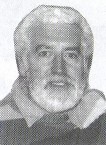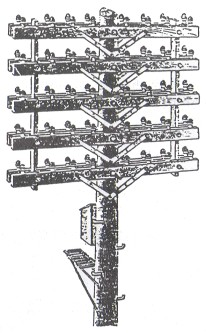Australian Collector, Noel Dawson
Reprinted from "Crown Jewels of the Wire", July 1997, page 26
"Besides being an avid insulator collector, I'm also a member of the
Australian Historic Telephone Society, mainly because of the communications link
with insulators. Many of the members are telephone linesmen who also take an
interest in insulators. Each month a newsletter is published and sent to members
and occasionally we have a member profile section. Being a little different to
most telephone collectors in that I am mainly an insulator collector, I was
asked to contribute an article on myself for the newsletter some twelve to
eighteen months ago."

I guess you could say my involvement with "Insulator Collecting" started back in 1980. At that time I
was enjoying some long
service leave with my wife Gail and 3 children. We were on a camping holiday
having traveled up through Alice Springs to Darwin and then down the west coast
to Perth. During this trip we became involved with the Azaria Chamberlain saga
at Ayers Rock, but that's a different story.

Whilst traveling from Wave Rock back towards Kalgoorlie, Gail spotted some
deep purple large glass bell (AGEE) insulators on poles without wires and
pleaded with me to stop and collect one. I sized up the situation and thought,
"There's no way I can get one down from those poles," and refused her
plea. She "sulked" all the way to Kalgoorlie, but at a junk shop there
she bought one of these "purple bells" for $6! This was her first
insulator -- a "CD 490 AGEE" (the Americans have a catalogue system of
CD numbers for identifying insulators).
Across the Nullabor, Gail looked at
every pole but still no interest from me. At Burra in South Australia, she bought "Insulator No.
2" -- a beautiful Hemingray CD 154 Aqua (these are still my favourite). At
this stage I became a bit more interested and cooperative, and from short poles,
by standing on Gail's shoulders, we were able to pick up several more glass as
well as some porcelain specimens by the time we got back to Geelong.

Fig. 535. Transposition Insulator
By now I
had become the "gopher" who had to climb up the ladder and unscrew the
disused insulators from the poles. I thought to myself, "This isn't such a bad hobby. It gets you out and about and there's a
sense of adventure. (Like avoiding snakes at the foot of poles and nasty black
spiders crawling out of insulators whilst unscrewing them 7-8 metres above the ground!) I became just as hooked on the hobby as my wife Gail.


Illustrations in the original article were taken from Internal Correspondence
School Textbook No. 165, (Telephony); Stationers Hall, London, 1906 & 1907.
THE INTEREST WIDENS
Gail however had more spare time than what I did, and she started to learn
about other people who collected insulators. By making numerous phone calls she
was able to track down one of our fellow AHTS members, Mike Hornabrook. Mike
lives at Naracoorte in South Australia, and we have been friends ever since.
Mike gave us other names to contact and so the Network began. Gail soon had
other insulator collectors around the country all corresponding with one
another, and we made many valued friends through insulator collecting. Indeed,
it was a tribute to Gail that many of these interstate friends visited her
during her final weeks (Gail died of cancer in 1994) and also attended her
funeral.
We had traveled widely in NSW, Southern Qld, Eastern SA and throughout
Victoria searching for old disused telephone lines and walking probably hundreds
of kilometers along railway lines in search of insulators, and thus built up one
of the best collections in Australia. There are several pieces which are
considered quite rare, one such being a CD 432 glass trunk line insulator. It is
a double wire groove experimental insulator used on a line between Melbourne and
Dromana in 1938. There are only 5 specimens known to be left in the world.
. . . AND GOOD FINDS BECOME HARDER!
Like all collections it becomes harder and harder to find something
different, and two pieces which I'm still looking for are a CD 494 Dark Green
Glass Isorex Bell Insulator (used during the 1930's), and an Earthenware Brown
Glass Morse Insulator which would have been used on very early telegraph lines.
Should any reader be able to guide me towards either of these insulators I would
be extremely grateful.
In my younger days I used to do a lot of hunting and fishing, including
shooting rabbits, foxes and pigs and found it quite exciting. I must confess
that hunting for insulators is just as exciting -- it's the thrill of the chase
and it's much more satisfying finding an insulator "in the wild" than
what it is finding one in an antique shop. I'm sure I've looked up all the poles
in Melbourne and I'm surprised that I've somehow not had a head on collision
with another car! The binoculars are always by my side.
In the USA Insulator
Collecting is quite a hobby and some insulators can bring big money. I've heard
of a "Pony Express" line insulator selling for 16,000 US dollars!
There are many Insulator Conventions held in the States, much like the Bottle
Conventions we have here.
IN CONCLUSION
My work colleagues think I 'm mad, but I have found insulator collecting to
be a very rewarding hobby, and there is much history to be learnt from tracing
back old telephone lines etc. Gail actually helped Rosemary Clencie at the
Telecom Historical Centre in Collingwood catalogue many of the insulators in the
Telecom museum collection.
| 